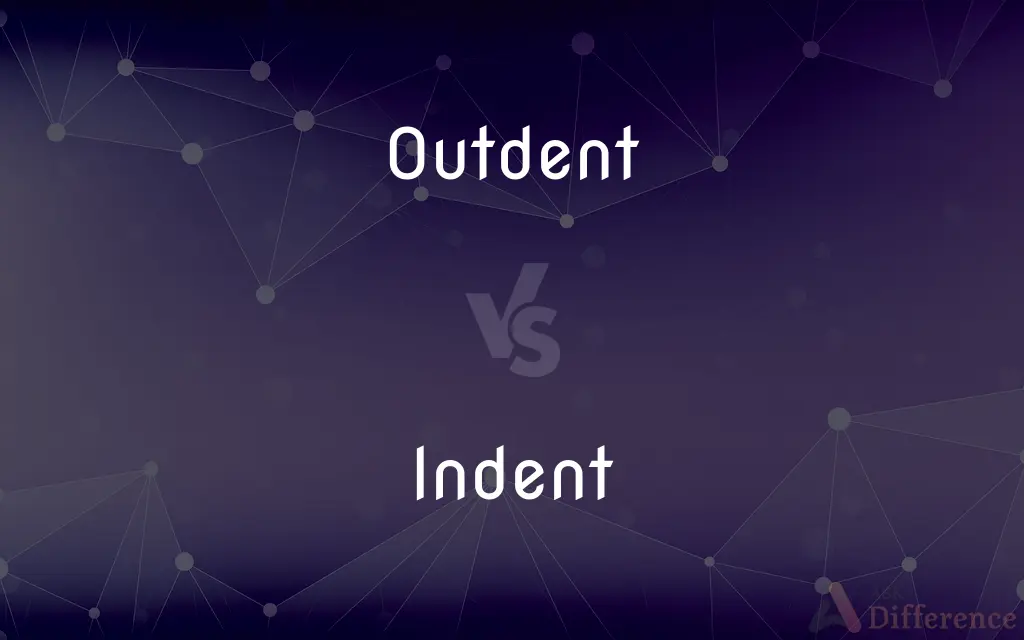Outdent vs. Indent — What's the Difference?
By Fiza Rafique & Maham Liaqat — Updated on April 20, 2024
Outdentation (or outdent) moves text outward, highlighting specific lines or paragraphs. While Indentation involves moving text inward from the margin to distinguish new paragraphs or section.

Difference Between Outdent and Indent
Table of Contents
ADVERTISEMENT
Key Differences
Outdents are less common and serve to highlight specific text by moving it outward, often beyond the standard alignment of the rest of the text. Conversely, Indenting text is a common formatting technique used to create a visual separation between paragraphs or to emphasize a new section within documents, traditionally by moving the first line of a paragraph towards the center of the page.
While indents are typically seen in academic and professional writing to denote new paragraphs or to format long quotes and bibliographies, outdents are frequently used in business writing and graphic materials like brochures or presentations to catch the reader's eye or to emphasize headings or important points.
Outdents have a more uniform application, primarily focusing on enhancing the visibility and importance of the text they modify. On the other hand, indents can be classified into different types, such as first-line indents (the most common) and hanging indents, which are used in bibliographic entries.
In terms of tools and settings, most word processors and text editing software easily allow users to adjust indents using rulers or menu settings. Outdents, while also supported by most software, might require more manual adjustments or the use of specific styles to ensure consistency across a document.
Indents contribute to the readability of long texts by breaking up large blocks of text into manageable pieces, thereby aiding the reader's flow from one idea to another. Outdents, while not enhancing readability in the traditional sense, act as strategic tools to draw attention to specific information or to organize content in a visually appealing manner.
ADVERTISEMENT
Comparison Chart
Definition
A formatting style that extends text outward beyond the regular margin.
A formatting style pushing text inward from the margin.
Primary Usage
To highlight and draw attention to specific text or sections.
To denote new paragraphs and organize long texts.
Common Types
Uniform, usually applied to specific lines for emphasis.
First-line indents, hanging indents.
Application in Writing
Business documents, marketing materials, presentations.
Academic papers, books, articles.
Visual Impact
Increases visibility and focus on important content.
Enhances text readability and flow.
Compare with Definitions
Outdent
Helps in creating visually dynamic layouts in documents.
She used an outdent for the testimonials in the brochure to make them stand out.
Indent
Can be adjusted in word processors by setting margins or using the tab key.
She set a first-line indent of half an inch for her document.
Outdent
Moves a line of text outward to align it with the left margin or beyond.
The bullet points were outdented to emphasize their importance in the presentation.
Indent
A paragraph beginning several spaces inside the margin line.
Academic essays typically use an indent to denote new paragraphs.
Outdent
Often paired with bold or italic styles for added emphasis.
Key terms in the document were outdented and bolded for emphasis.
Indent
Used in lists and quotes to separate items visually.
Each entry in the bibliography must have a hanging indent.
Outdent
Commonly used in graphic design to create a focal point.
The flyer featured an outdented call-to-action to attract attention.
Indent
Enhances the organization of text by visually grouping similar ideas.
The contract used indents to separate clauses for clarity.
Outdent
Useful in business writing to highlight critical information quickly.
The proposal included outdented headings to guide the reader through sections.
Indent
Often required in formal and academic writing to meet style guidelines.
The thesis guidelines stipulated using an indent at the start of each paragraph.
Outdent
A hanging paragraph.
Indent
Start (a line of text) or position (a block of text) further from the margin than the main part of the text
Type a paragraph of text and indent the first line
Outdent
To indent negatively, bring towards the margin; to remove an indent.
By default, the summary tasks are bold and outdented, and the subtasks are indented beneath them.
Indent
Form deep recesses or notches in (a line or surface)
A coastline indented by many fjords
Indent
Make a requisition or written order for something
We were indenting for paper clips one by one in those days
Indent
Divide (a document drawn up in duplicate) into its two copies with a zigzag line, thus ensuring identification and preventing forgery.
Indent
Make a dent or impression in (something)
Sometimes voting-hole rectangles are merely indented by the voter's stylus
Indent
An official order or requisition for goods
Hawthorn refused to approve the indent for silk scarves
Indent
A space left by indenting text
Six-character indents
Indent
An indentation
Every indent in the coastline
Indent
An indenture.
Indent
To set (the first line of a paragraph, for example) in from the margin.
Indent
To cut or tear (a document with two or more copies) along an irregular line so that the parts can later be matched for establishing authenticity.
Indent
To draw up (a document) in duplicate or triplicate.
Indent
To notch or serrate the edge of; make jagged.
Indent
To make notches, grooves, or holes in (wood, for example) for the purpose of mortising.
Indent
To fit or join together by or as if by mortising.
Indent
Chiefly British To order (goods) by purchase order or official requisition.
Indent
To make or form an indentation.
Indent
Chiefly British To draw up or order an indent.
Indent
To impress (a design, for example); stamp.
Indent
The act of indenting or the condition of being indented.
Indent
A blank space before the beginning of an indented line
A two-pica indent.
Indent
An indenture.
Indent
A US certificate issued at the close of the American Revolution for interest due on the public debt.
Indent
Chiefly British An official requisition or purchase order for goods.
Indent
An indentation.
Indent
A cut or notch in the margin of anything, or a recess like a notch.
Indent
A stamp; an impression.
Indent
A certificate, or intended certificate, issued by the government of the United States at the close of the Revolution, for the principal or interest of the public debt.
Indent
A requisition or order for supplies, sent to the commissariat of an army.
Indent
(transitive) To notch; to jag; to cut into points like a row of teeth
To indent the edge of paper
Indent
(intransitive) To be cut, notched, or dented.
Indent
To dent; to stamp or to press in; to impress
Indent a smooth surface with a hammer
To indent wax with a stamp
Indent
(historical) To cut the two halves of a document in duplicate, using a jagged or wavy line so that each party could demonstrate that their copy was part of the original whole.
Indent
To enter into a binding agreement by means of such documents; to formally commit (to doing something); to contract.
Indent
To engage (someone), originally by means of indented contracts.
To indent a young man to a shoemaker; to indent a servant
Indent
(typography) To begin (a line or lines) at a greater or lesser distance from the margin. See indentation, and indention. Normal indent pushes in a line or paragraph. "Hanging indent" pulls the line out into the margin.
To indent the first line of a paragraph one em
To indent the second paragraph two ems more than the first
Indent
To crook or turn; to wind in and out; to zigzag.
Indent
To make an order upon; to draw upon, as for military stores.
Indent
To notch; to jag; to cut into points like a row of teeth; as, to indent the edge of paper.
Indent
To dent; to stamp or to press in; to impress; as, indent a smooth surface with a hammer; to indent wax with a stamp.
Indent
To bind out by indenture or contract; to indenture; to apprentice; as, to indent a young man to a shoemaker; to indent a servant.
Indent
To begin (a line or lines) at a greater or less distance from the margin; as, to indent the first line of a paragraph one em; to indent the second paragraph two ems more than the first. See Indentation, and Indention.
Indent
To make an order upon; to draw upon, as for military stores.
Indent
To be cut, notched, or dented.
Indent
To crook or turn; to wind in and out; to zigzag.
Indent
To contract; to bargain or covenant.
To indent and drive bargains with the Almighty.
Indent
A cut or notch in the margin of anything, or a recess like a notch.
Indent
A stamp; an impression.
Indent
A certificate, or intended certificate, issued by the government of the United States at the close of the Revolution, for the principal or interest of the public debt.
Indent
A requisition or order for supplies, sent to the commissariat of an army.
Indent
An order for goods to be exported or imported
Indent
The space left between the margin and the start of an indented line
Indent
Set in from the margin;
Indent the paragraphs of a letter
Indent
Cut or tear along an irregular line so that the parts can later be matched for authentication;
Indent the documents
Indent
Make a depression into;
The bicycle dented my car
Indent
Notch the edge of or make jagged
Indent
Bind by or as if by indentures, as of an apprentice or servant;
An indentured servant
Common Curiosities
What is the purpose of indenting in text?
Indenting organizes and separates text to improve readability and to denote new paragraphs or sections.
Where is outdenting commonly used?
Outdenting is commonly used in business documents, marketing materials, and presentations to make specific information stand out.
Can indenting and outdenting be used together in a document?
Yes, both can be used in the same document to organize and emphasize different parts of the text effectively.
What are some typical settings for indenting in a word processor?
Common settings include first-line indents for paragraphs and hanging indents for bibliographies and references.
How does outdenting improve document design?
Outdenting improves document design by creating a visual break and drawing attention to key points, enhancing the document's aesthetic and functional appeal.
How do I create an outdent in Microsoft Word?
In Microsoft Word, you can create an outdent by adjusting the left margin for selected text or using the decrease indent button.
What challenges might one face when using outdents?
Challenges include maintaining a balanced and cohesive document layout and ensuring that the outdent does not disrupt the overall readability of the text.
Are indents necessary in all types of writing?
While not necessary in all types of writing, indents are standard in academic, business, and formal writing to enhance clarity and structure.
How do digital platforms handle indenting and outdenting?
Digital platforms like word processors and web editors provide tools to easily adjust indents and outdents, though the exact methods and options can vary.
How does an outdent function differently from an indent?
An outdent extends text outward to highlight and draw attention, whereas an indent generally pulls text inward to denote starts of new paragraphs or sections.
What is a hanging indent?
A hanging indent is a type of indent where the first line of a paragraph is not indented, but subsequent lines are.
Is outdenting considered a professional formatting technique?
Yes, outdenting is considered professional when used appropriately to highlight important information or to create visually appealing document layouts.
Can indents and outdents affect the perception of a document?
Yes, the use of indents and outdents can significantly affect how information is perceived, guiding the reader's attention and impacting the document's navigability and aesthetics.
What are some best practices for using indents and outdents in business communications?
Best practices include using indents for clarity and structure, and outdents for emphasizing key points, ensuring that the document remains easy to read and visually engaging.
Are there specific guidelines for the amount of indentation in formal documents?
Yes, many style guides specify the amount of indentation, typically recommending about a half-inch indent for new paragraphs.
Share Your Discovery

Previous Comparison
Synchronicity vs. Synchrony
Next Comparison
Item vs. DittoAuthor Spotlight
Written by
Fiza RafiqueFiza Rafique is a skilled content writer at AskDifference.com, where she meticulously refines and enhances written pieces. Drawing from her vast editorial expertise, Fiza ensures clarity, accuracy, and precision in every article. Passionate about language, she continually seeks to elevate the quality of content for readers worldwide.
Co-written by
Maham Liaqat













































